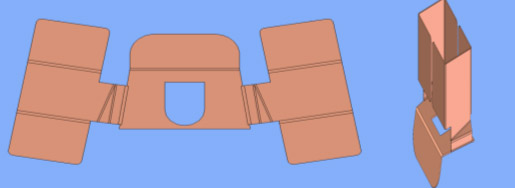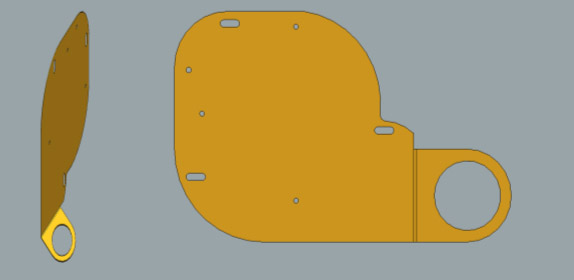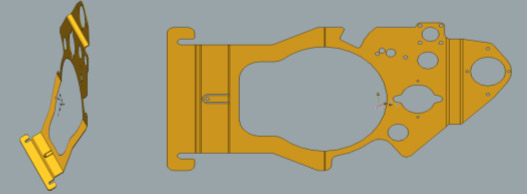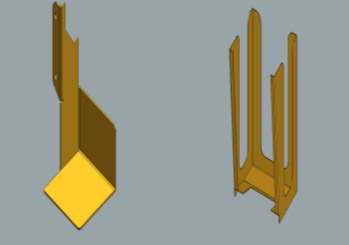Our Project Portfolio
Offshore Equipment
Drilling Barges:
Barges are small and compact drilling platform, suitable for shallow water operations, for initial prospecting of oil or regular deepening of well head. They are more mobile and technically less complicated to operate and maneuver. The hull structure is mostly rectangular in shape without self-propellant. They are moored to bed either in sea, river catchment area or in a lake, and can drill up to a depth of 2000m to 5000m. Barges contain the following system/equipment: - Drilling platform supported by the cantilever structure on movable substructure, - Derrick structure along with draw works, - Pipe handling system, - Power plant, - BOP Equipment: diverter, stack and control system, - Mud handling and Treatment, - Cranes, - Storage area to handle bulk material like cement, drilling water, fuel for generator and Mud tanks, - Accommodations for Staff: normally for about 70 to 100 persons with helideck.
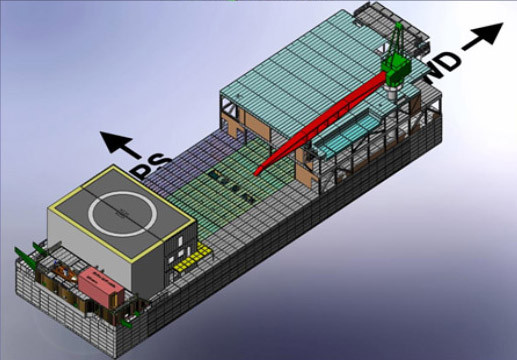
Jack-Up rigs:
Unlike barges, which is suitable for near shore operation with calm weather, the jack-up rigs can operate in harsh weather conditions in violate sea. The high tech rigs in a triangle shaped hull, supported by three legs can move up and down depending on water level in the sea. Due to stable mooring facility, they can operate at high speed to a depth of 8000m. Like barge, they are not self-propellant. Jack-up rigs contain the following system/equipment: - Drilling platform supported by the cantilever structure on movable substructure, - Derrick structure along with draw works, - Pipe handling system, - Power plant, - BOP Equipment: diverter, stack and control system, - Mud handling and Treatment, - Cranes, - Storage area to handle bulk material like cement, drilling water, fuel for generator and Mud tanks, - Accommodations for Staff: normally for over 100 persons, - Helideck on cantilever structure. - Jack-up facility up to 200m

Semi-submersible:
These types of drilling rigs are capable of operating in deep sea to the depth of 3000m with high-tech dynamic positioning system to maintain its station or with a pre-laid mooring. The hull structure is normally consists of a platform with four legs and its drilling operation located at the center. Most of the equipment and systems are built around the legs with the support of cantilever. This configuration enhances the flexibility of operation of the rigs to carryout simultaneous activities thus, reducing the drilling time and cost of operation. Apart from standard equipment, stated in jack-up rigs, they have equipped with: - State of the art drilling facilities can drill up to a depth of 10000m measured from subsoil level, - Optimized hull structure facilitate in deep drilling at faster rate, - Dynamic positioning system, - Offline capability enhances the efficient and safe operation, - Back-up facility for all main equipment cut-down the down time and saves the operation cost, - Can accommodate more than 150 crew members at a time. CES for the past several years have associated with offshore partners in retrofitting and modernization of various Barges and Platform in the following areas:

Blow-Out Preventers (BOP) Stack
The main constituents of BOP equipment are Annular BOP, Stack BOP, Gate Valves, Ram door opener and a Working platform for easy access and maintenance of BOP. The Operating pressure of BOP varies from 3000PSI to 15000PSI depending upon the requirements. The function of BOP during the drilling operation is to control the sudden surge in well pressure or massive kick-out, through a hydraulically operated ram to close the well with or without drill pipe. It facilitates change of drill pipe even under moderate well pressure. BOP stakes is also equipped with choke and kill manifold to send the Drilling fluid (mud) to well in case of kick. Thus, the BOP controls all phases of drilling operations effectively through, hydraulically, remote controlled panels in the Rig/barge.
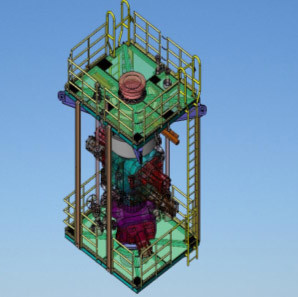
Drilling Deck
Drilling deck, where drilling operation performed, is mounted on hull structure with the aid of movable cantilever beams directly below derrick. It houses various associated equipment/machinery, such as, draw works, rotary table, Kelly drive, drill line, drill string and derrick with drill pipe stand. Below the drill floor flow line is located through bell nipple to facilitate the return of drilling fluid (mud) to mud tanks. CES has also carried out modification in moon pool area to accommodate foldable BOP storage area, cellar deck, pathways, mud lab etc.

Helidecks
Helideck is an integral part of the main structure of barges, jack-ups and semi-submergible to facilitate smooth transport of men and materials from main land. Helidecks are either mounted outboard with cantilever support or above the accommodation block and located mainly on the AFT side A typical cantilever type Helideck Thus, this vital support system of all offshore operation is positioned in such a way to enable easy access in landing and departing of helicopters. Helideck is used as a primary escape route for the personnel to move away from hazards in case of emergencies. The helideck includes fire protection system, fueling systems, navigation aids, lighting, emergency alarms and public address systems.

Rescue Boat
All modern drill rigs are provided with a rescue boat, apart from inflatable boats, which can be operated through winches to lower the personnel from deck in case of emergencies to getaway as far as away from site. The rescue boat shelter is built near the accommodation block on a cantilever beam structure, with access ways and crew assembly area, in such a way that the boats can be lowered to sea water directly. CES has carried out helideck and rescue boat structure modifications, retrofits, additional safety facilities for various drill rigs and barges.

Cranes
Cranes play important role in drilling operation of rigs/barges efficiently. Cranes are oriented in the barges/drill rigs at AFT-STBD and AFT-PORT side of the with boom length of 30 to 40m and safe lifting capacity from 30000kgs to 50000kgs.

Shell Shaker house structure
CES has developed Shell Shaker house structure in the past for one of its client for refitting of equipment’s shown below:

Diverter Housing and pipe lines with drain
Complete refitted Diverter housing, for one of its client, is shown here:
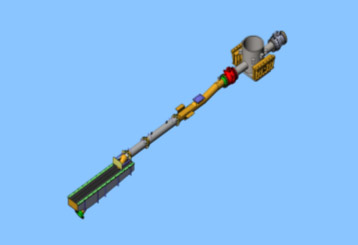
BOP access platforms
BOP platforms are built around the stack to facilitate easy access to BOP Stack for repair and maintenance as shown in the picture. CES has carried out BOP platform modifications, retrofits, additional facilities for various drill rigs and barges.
Associated BOP Parts
Bop Speed Lock, Bop Storage, Test Mandrel, Bell nipple, Bop Ram, Annular, Test Stump, Choke manifold, Choke and kill line, Diverter Saddle, Diverter Housing, Gate Valve developed are shown here:
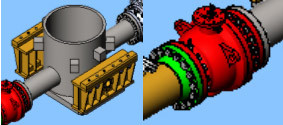
Cellar deck
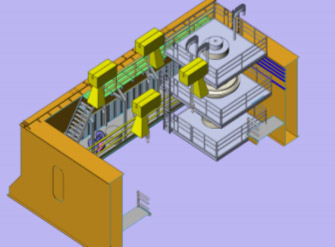
Cabin and Engine Module and Stairs and walkways

Pipe Rack Sub Structure and Sub Base

Moon pool area and Pipe storage area

Offshore trestle bridges and Flare towers
A Trestle is a rigid frame typically composed of a horizontal top chord and bottom chord rigidly connected by diagonal and vertical supports to form a short span bridge to the designated area. Normally one end of spans is pivoted to a common deck and the other end rest on a sliding bearing. The deck is supported by piles and jacket arrangement. Provision is made for catwalks utility platforms on the bridge as per project requirement. The flue gases from the processing plant are connected to flare towers to burnout safely at pre- determined height via the trestle bridges.
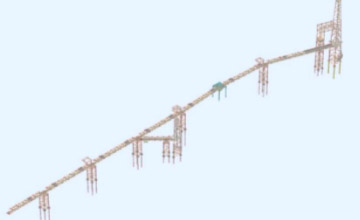
3D model of Trestle bridge and Flare towers
CES has involved in development trestle consists of 8 bridges over 80m span. It includes a 55m high LP flare tower and a 105m high HP flare tower. Pile depth of over 50m meters were supported by a jacket from mud level. The development includes supply of manufacturing drawings sub assembly and assembly drawing. A separate drawing for nesting of plates issued category wise and issued pipe nesting and copping drawings. A detailed MTO (material take off) list was prepared for pipes, plates, round bars, fasteners, bought-out-item etc. Around 4000MT of steel were processed to fabricate flare trestle apart from supply item issued by client.

Deck structure
A typical duct structure consists of Tubular legs with braces and an interconnected plate girder to form a flat support to rest the one end of the bridge through a slide bearing. The other end of the bridge is pinned through a guide. The two end of the bridge is connected through walking platform.
Jacket Structure
Jacket structure consists of welded Tubular legs interconnected with horizontal and diagonal tubular braces. At the bottom of legs a dish shaped mud-mat is fixed to rest at the sand of sea bed.
Bridge
Bridge structure includes bottm chord, top chord, veritical and digonal braces, walkways, pipe supports, lifting padeys, heatshields and with or without cantiliver platforms. The top and bottom chords are made out of plate rolled into cans and welded and joined through seam welding. Can lengths are predetermined and located in such a way to avoid the over lapping of welds with brace connections and/or padeys as well as conection platform etc, as per EEMUA (Engineering Equipment and Materials Users Association) standards. A sturdy saddle mount is provided at bottom chord for resting the bridge over the deck. A build in pre-chamber is part of the design to avoid sag due to its load. A bumper guide is in build on all bridges and jackets to keep proper alignment while erecting. At bottom chord a walkway is provided for operation and maintenance personnel to carry out their day to day work. Also provision for heat shield is provided at key areas to protect instruments and fittings. At key areas, working platforms are fitted with cantilever structure on bottom and top chord. Provision for ladders safety gates, and handrails are provided all around on such structures.

Flare tower
Flare tower is normally a tripod shaped structure made up tubular cans connected with horizontal and diagonal braces to support flare pipe at the center. At the top a working platform with provision for davits to lower and mount the flare burners are provided. At one of the faces, at sea level, a boat landing facility is provided for easy access for man and material. At lower level a working platform is provided to connect the last end of the connecting bridge. A set of Intermediate landing platform connects the lower platform with top working platform through ladders. Apart from insulation on flare pipe, depending upon radiations level of flare flame, the structure is divided in to various temperature zones to apply fire retardant paints to protect the structure.
Storage Tank
Welded Steel Storage tank as per API 650
The welded steel storage tank can be categorized in the following types based on its mounting such as: - Flat bottom tanks - Tanks Mounted on skirts - Tanks Mounted on legs The main components of storage tank includes Shell, Nozzles, pipes, Vent, Drain holes, Manholes, level indicator etc. They can also be with or without a platform at top. Provision is made for internal ladder, external ladder with handrails & safety cage, for easy access. Anchor bolt brackets are provide to fasten the tank to a base structure or a foundation. The designs of Storage Tanks are governed by API 650 Specification: “Welded steel tanks for storage-2007”. Based on this specification the nozzles holes openings in the tank shell are determined and welding specifications are worked out. All fittings such as manhole covers, flange and cover plate thickness, bolt holes diameter and no off bolts etc., are also governed by the API 650. Basic shell design and validity are determined based on the formulae from API 650 Spec. The size, position, etc. for shell plate segments are kept as per API 650 norms. CES have developed detailed design and manufacturing drawings for 11 tanks in the range of 2m to 6m in diameter and 25 m3 to 175m3 involume.
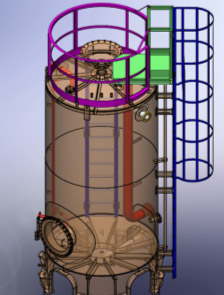
Water Storage Tank FEA Results
CES has carried out Finite Element Analysis for 30 meter diameter Flat bottom Water Storage Tank for one of the clients in Middle East for the reliability of its structural design. Sample pictures are given below.
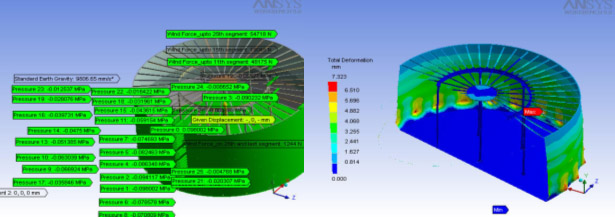
Onshore work
Ship Loader
Ship Loaders are huge structures like mobile crane mounted on wheels are along a track to cater the safe transfer of bulk materials like mineral ores, coal, fertilizers, food grains etc., in to a ship at a faster rate. The boom which is equipped with fast moving conveyers, bucket elevators, suction and/or discharge modules, utility modules and control unit, mounted on a huge leg structure can discharge 1000tph to 15000tph. Apart from fast loading the boom can be manipulated, up and down or to and fro, to enable even filling of bulk materials in a cargo hold. CES has associated in development of ship loaders for various discharge capacities.
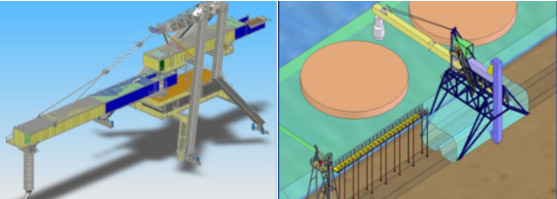
Wind turbine development and testing
A wind turbine consists of the following systems and combination of equipment’s to generate electricity from wind power. 1. Blades, 2. Rotor, 3. Pitch controller, 4. Brakes, 5. Transmission 6. Generator, 7. Power Controller, 8. A nacelle (housing to accommodate the above), 9. Tower, 10. Yoke drive, 11. Wind vane and anemometer to aid in achieving max output. CES has developed nacelle structure, test rigs with climate chamber box for generator and gear-box testing, blade transport system and nacelle transport system for their overseas client in the past.
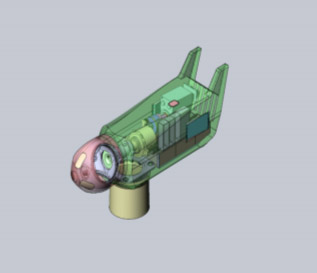
Test Rigs for wind turbine generators
Wind turbuine are installed and operated in exterme climate conditions like hot and humid region, dry and exterme cold condtions or in artic sea to harvest wind power. The reliblity of generators are tested in Lab by stimulating the above condtions in a test bench fitted with climate chambers. CES has developed and issued manufacturing drawings for fabrication test bench for various capacities with or without climate chambers including access platform for operation and maintenance. CES also developed a complete wind turbine test rig to stimulate extreme weather conditions and issued manufacturing drawings.

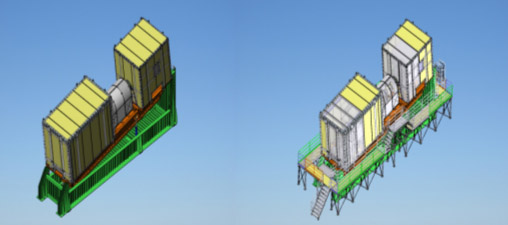
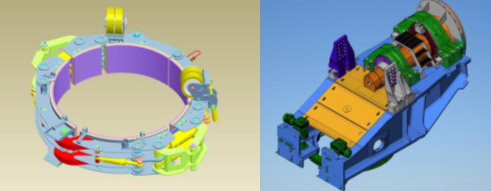
Nacelle structure and outer shell
CES has developed in the past for one its client a Nacelle structure with outer shell and spinner cover above the rotor and issued complete set of manufacturing drawing.
Mining
CES has developed in the past for one of its client a Truck mounted Drilling rig with Mud logging unit to facilitate the on-site verification of soil testing and excavation of mineral etc., a typical drilling unit shown here. CES also carried out FEA on modified parts for the drilling rig and the results are shown below:

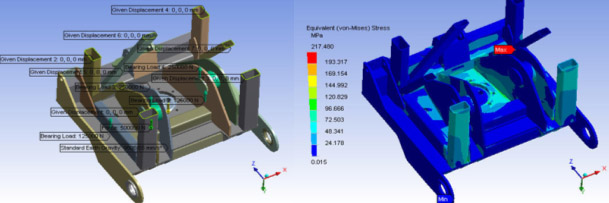
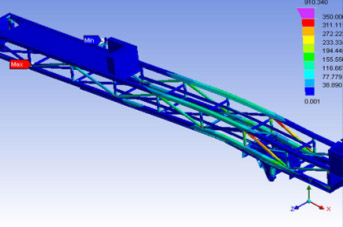
Bag Filter for cement plant
CES has developed a complete structural part of a bag filter system for one of their client in the past. The scope includes sizing of the support structure column, beam and braces and design validation of key elements through Finite Element Analysis. Detailed manufacturing drawings are exerted from 3D models and issued Material Take Off list (MTO) for procurement. There are 2880 filter bags having 200 mm in diameter in the assembly spread over an area 216m2. Apart from main structure CES has developed walkway around pent house, access and working platforms, staircase structure and duct support structure for Bag filter unit.
Main Structure
Main structure consists of 12 welded steel column bolted with 36 welded horizontal steel beams. Further it bolted with steel tubular wind braces. An extended cantilever platforms support by tubular braces is provided to rest the exhaust duct.

Hopper
Hopper is made of 5mm thick steel sheet shaped as per design requirement. It is split in to various welded sections and joined with fasteners. Wind braces of tubular steel is bolted inside and vertical and horizontal L-profile is welded all around the hopper outer walls to give sufficient strength. Welded sturdy mounting bracket at 12 places at the top frame is bolted to main structure. In built Manholes and baffle are provided for easy maintenance.

Bag house and pent house
Bag house and pent house is made up of thin steel sheet panels and joined by fasteners to form side walls. Then all walls are bolted to Steel Tubular wind braces to required shape and size. A roof at the top and doors at the side wall of pent house is provided for easy access.

Access platform
At all levels a platform is provided along with staircase for easy access to various sections of baghouse.

Exhaust Duct and duct support structure
To facilitate the exhaust fume out of the baghouse a duct system with support structure is provide as shown
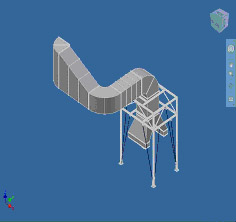
Steel plant equipment and maintenance support equipment
CES in the past has involved in the development of Steel plant equipment and maintenance support equipment. Some the equipment’s 3D model is shown below:
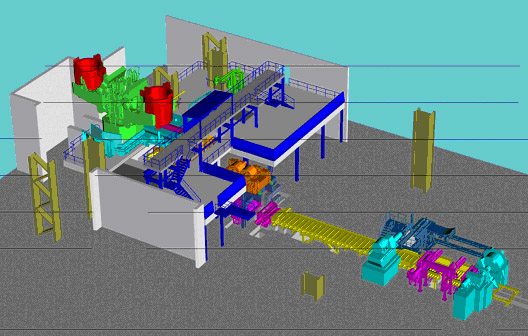
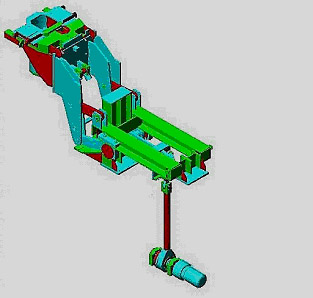
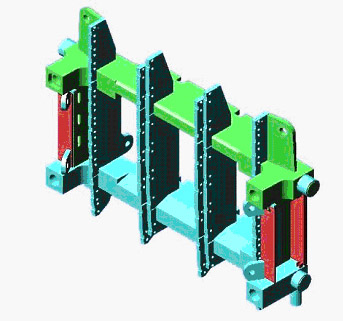
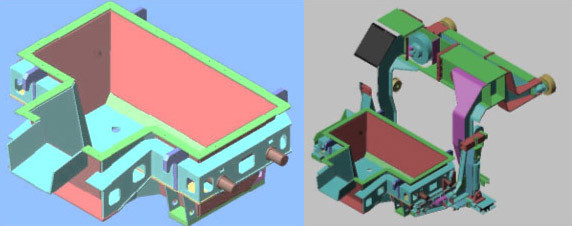
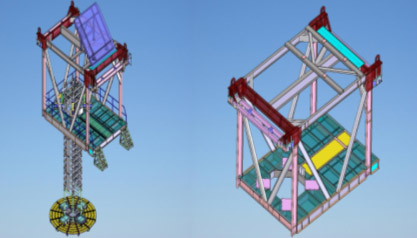

Sugar Industries Equipment
CES has developed a vertical Super-heated steam dryer for one of its client and shown in pictures below:
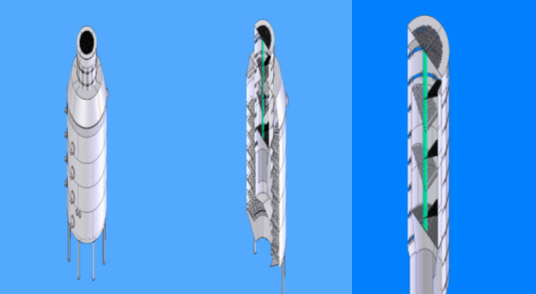

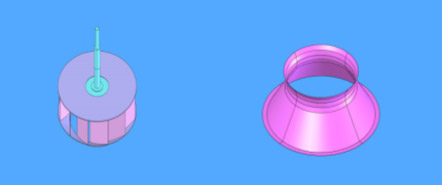
Food processing Equipments Design by CES
For one of its client in Europe CES has developed, Food Processing equipment, using advanced parametric software such as PRO-E to customize machines as per client requirement.
Blanchers are manufactured to meet individual customer needs. Capacities range from 1 to 30 t/h. Special versions for blanching machine design are also available for leaf vegetables such as spinach, and for cooking of rice and pasta.
The Flow Separator is designed to separate light particles from heavier particles, e.g. leaves, sticks etc. from fruit and vegetables or shells from mechanically peeled cold water shrimp. The principle is to create airflow, which is powerful enough to blow the light particles away and keep the heavier parts in the main flow. The flow separator for vegetables is equipped with: Axial fan, Safety guard in front of the fan, Air duct, to control and guide the air flow, mounted with inspection traps, Air hood, on top of the air duct, where foreign matters are collected. Small screw conveyor integrated in the air hood to remove foreign matters from the air hood.



It is used to pre-sort the shrimps into two grades in order to facilitate determination of the cooking time. The grader consists of two through-going screws with increasing pitch (helix), one on each side. Horizontal stainless steel rollers are mounted between the two screws and connected by a stainless steel chain on each side. The rotating rollers gently transport and grade the product as the space between the rollers is progressively increased. The grader is fitted with two longitudinally adjustable chutes, which are placed below the rollers to collect and discharge graded product onto conveyor belts. These chutes are used to determine the proportion between the two grades and they can be adjusted +/- 100 mm.
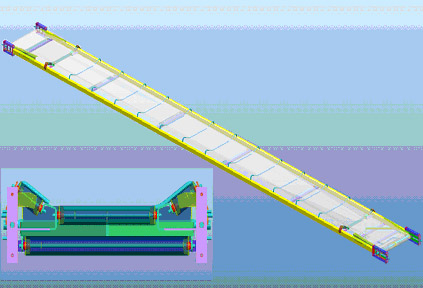
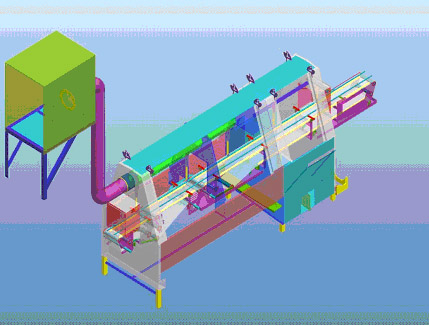
Rail Transport Equipment Design by CES
CES has also into the Rail Transport segment and provided design services to various clienteles in EUROPE for the development of Modular WC cabins, enclosure for modern Toilet systems in High speed trains. Some of the work carried out by CES is shown below:
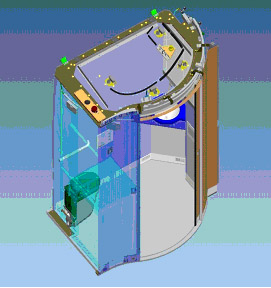
Some of the assembly developed for Toilet system consists of Bowl, ventricle, water pressurizer, holding waste tank, control units are shown below:
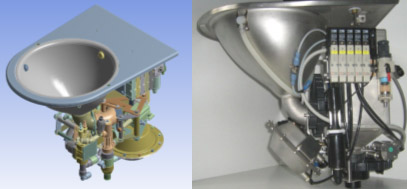
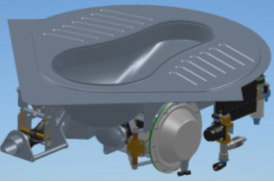

Special Equipments Designed by CES
CES has developed various special purpose machine/structure to cater the need of clients which are listed below:
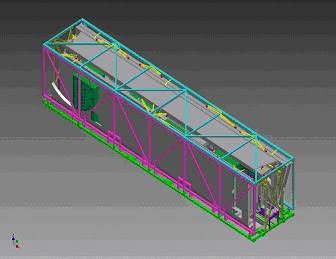
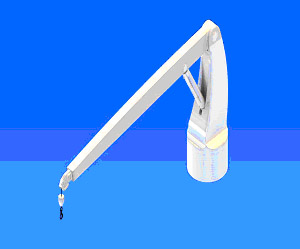

Special Equipments Designed by CES
CES has developed various special purpose sheet metal components to cater the need of clients which are listed below:
